
Orchids are plants that belong to the family Orchidaceae, a diverse and widespread group of flowering plants with blooms that are often colourful and fragrant.

In the botanical classification of plants, Aeridinae Pfitzer is a subtribe of the tribe Vandeae whose representatives all have a monopodial growth habit and do not possess pseudobulbs.

Vanda, abbreviated in the horticultural trade as V., is a genus in the orchid family, Orchidaceae. There are about 87 species, and the genus is commonly cultivated for the marketplace. This genus and its allies are considered to be among the most specifically adapted of all orchids within the Orchidaceae. The genus is highly prized in horticulture for its showy, fragrant, long-lasting, and intensely colorful flowers. Vanda species are widespread across East Asia, Southeast Asia, and New Guinea, with a few species extending into Queensland and some of the islands of the western Pacific.

The Singapore Botanic Gardens is a 163-year-old tropical garden located at the fringe of the Orchard Road shopping district in Singapore. It is one of three gardens, and the only tropical garden, to be honoured as a UNESCO World Heritage Site. The Botanic Gardens has been ranked Asia's top park attraction since 2013, by TripAdvisor Travellers' Choice Awards. It was declared the inaugural Garden of the Year, International Garden Tourism Awards in 2012.

Vanda Station was an Antarctic research base in the western highlands of the Ross Dependency, specifically on the shore of Lake Vanda, at the mouth of Onyx River, in the Wright Valley.

× Ascocenda, abbreviated as Ascda in the horticultural trade, was a man-made hybrid orchid genus resulting from a cross between the former genus Ascocentrum and Vanda. It was first described in Orchid Rev. 57: 172 (1949). Ascocentrum is now synonymous with Vanda, so the name is obsolete. Hybrids in the nothogenus × Ascocenda are now properly termed Vanda.

Sarcochilus, commonly known as butterfly orchids or fairy bells is a genus of about twenty species of flowering plants in the orchid family, Orchidaceae. Most species are epiphytes but a few species only grow on rocks or in leaf litter. Orchids in this genus usually have short stems, leaves arranged in two rows and flowers arranged along unbranched flowering stems. Most species are endemic to Australia but some are found in New Guinea and New Caledonia.
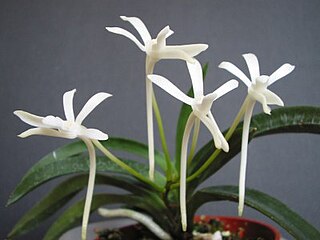
Neofinetia was a genus of flowering plants from the orchid family, Orchidaceae, that is now classified as a Vanda. It contained three species and was distributed in China, Korea, and Japan.

Vanda christensoniana is a species of orchid endemic to Vietnam. The specific epithet christensoniana honours the botanist and taxonomist Eric Christenson.

Vanda denisoniana is a species of orchid found from China (Yunnan) to northern Indochina. It was named after Lady Ida Emily Augusta Denison, an orchid enthusiast.
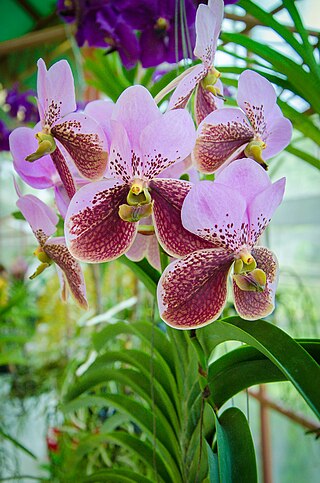
Vanda sanderiana is a species of orchid. It is commonly called Waling-waling in the Philippines and is also called Sander's Vanda, after Henry Frederick Conrad Sander, a noted orchidologist. The orchid is considered to be the "Queen of Philippine flowers" and is worshiped as a diwata by the indigenous Bagobo people.

Papilionanthe Miss Joaquim, also known as the Singapore orchid, the Princess Aloha orchid and formerly as Vanda Miss Joaquim, is a hybrid orchid that is the national flower of Singapore. For its resilience and year-round blooming quality, it was chosen on 15 April 1981 to represent Singapore's uniqueness and hybrid culture.

Papilionanthe is a genus of flowering plants from the orchid family, Orchidaceae. It is native to Southeast Asia, southern China, and the Indian Subcontinent.

Vanda falcata, the wind orchid, is a species of orchid found in China, Korea, and Japan. It was formerly classified in the genus Neofinetia.
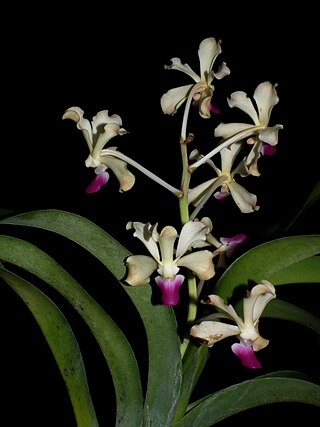
Vanda ustii, the University of Santo Tomas' vanda, is an orchid species found only in the Philippines. It is named after the University of Santo Tomas or U.S.T.
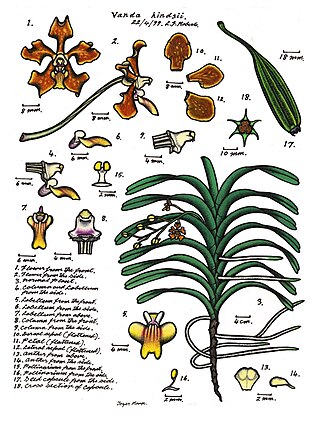
Vanda hindsii, commonly known as the native strap orchid or the Cape York vanda, is a large epiphytic or lithophytic clump-forming orchid. It has thick, white, cord-like roots, branching stems, many thick, leathery, strap-like leaves and between three and seven shiny brown flowers with greenish to yellow markings and a white labellum. This orchid occurs in New Guinea and tropical North Queensland.
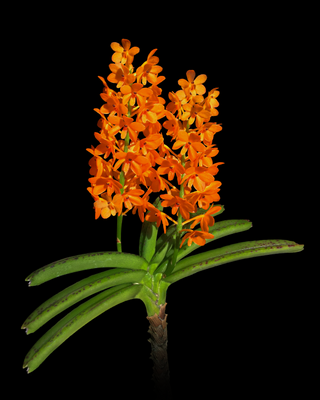
Vanda garayi, or Garay's ascocentrum, is a small monopodial epiphytic orchid native to semi-deciduous and deciduous dry lowland forests of Thailand, Laos, and Sumatra.

Vanda xichangensis is a species of epiphytic orchid native to China South-Central. It differs in the spur length from Vanda falcata. Some authors dispute this species status and regard it as a subspecies of Vanda falcata. Dr. Martin Motes argues against effective isolating mechanisms of the length of the spur. Accorting to Motes, the variation of this characteristic easily falls within a species range of variation and further research might reduce it to a varietal status.

Vanda richardsiana is a species of epiphytic orchid native to China South-Central. It differs in the spur length from Vanda falcata. Some authors dispute this species status and regard it as a subspecies of Vanda falcata. Dr. Martin Motes argues against effective isolating mechanisms of the length of the spur. Accorting to Motes, the variation of this characteristic easily falls within a species range of variation and further research might reduce it to a varietal status.

Vanda dives is a species of epiphytic orchid native to Vietnam and Laos.



















